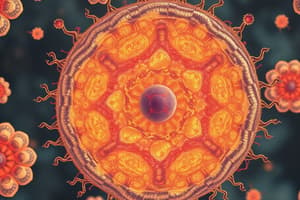Podcast
Questions and Answers
What is the primary purpose of photosynthesis in plants?
What is the primary purpose of photosynthesis in plants?
- To break down glucose for energy production
- To consume atmospheric oxygen
- To convert light energy into chemical energy (correct)
- To release ATP for energy utilization
Which process requires oxygen for energy production in organisms?
Which process requires oxygen for energy production in organisms?
- Anaerobic respiration
- Photosynthesis
- Aerobic respiration (correct)
- Fermentation
What is the role of ATP in cells?
What is the role of ATP in cells?
- To store glucose
- To facilitate photosynthesis
- To provide energy for cellular processes (correct)
- To act as a genetic material
How do aerobic and anaerobic respiration differ primarily?
How do aerobic and anaerobic respiration differ primarily?
What does the process of metabolism encompass?
What does the process of metabolism encompass?
What is the main difference between prokaryotic and eukaryotic cells?
What is the main difference between prokaryotic and eukaryotic cells?
Which of the following mechanisms is NOT a method of substance movement across cell membranes?
Which of the following mechanisms is NOT a method of substance movement across cell membranes?
Which statement best describes the role of the nucleus in a eukaryotic cell?
Which statement best describes the role of the nucleus in a eukaryotic cell?
What characteristic distinguishes tissues from cells?
What characteristic distinguishes tissues from cells?
How does vaccination prepare the immune system?
How does vaccination prepare the immune system?
What is the primary function of mitochondria in eukaryotic cells?
What is the primary function of mitochondria in eukaryotic cells?
Which of the following immune responses is considered specific?
Which of the following immune responses is considered specific?
What triggers an inflammatory response?
What triggers an inflammatory response?
Flashcards
Prokaryotic Cell
Prokaryotic Cell
A cell that lacks a nucleus and membrane-bound organelles, like bacteria and archaea.
Eukaryotic Cell
Eukaryotic Cell
A cell with a nucleus and membrane-bound organelles, like mitochondria and chloroplasts, found in plants and animals.
Cell Membrane
Cell Membrane
A thin, selectively permeable barrier that controls the movement of substances in and out of the cell.
Tissue
Tissue
Signup and view all the flashcards
Organ
Organ
Signup and view all the flashcards
Pathogen
Pathogen
Signup and view all the flashcards
Immune System
Immune System
Signup and view all the flashcards
Antigen
Antigen
Signup and view all the flashcards
Bioenergetics
Bioenergetics
Signup and view all the flashcards
Photosynthesis
Photosynthesis
Signup and view all the flashcards
Respiration
Respiration
Signup and view all the flashcards
Aerobic Respiration
Aerobic Respiration
Signup and view all the flashcards
Anaerobic Respiration
Anaerobic Respiration
Signup and view all the flashcards
Study Notes
Cell Biology
- Cells are the basic units of life, exhibiting a wide range of structures and functions.
- Prokaryotic cells lack a nucleus and membrane-bound organelles. Examples include bacteria and archaea.
- Eukaryotic cells have a nucleus and membrane-bound organelles like mitochondria and chloroplasts. Examples include plant and animal cells.
- Cellular structures perform specific functions: e.g., the nucleus contains DNA, ribosomes synthesize proteins, mitochondria generate ATP.
- Cell membranes are selectively permeable, controlling the movement of substances in and out of the cell.
- Diffusion, osmosis, and active transport are mechanisms for substance movement across cell membranes.
- Specialized cells are adapted for specific functions through structural and functional differences. e.g., nerve cells have long extensions for rapid signaling.
Organisation
- Organisms are organized into levels, from cells to organisms, with each level exhibiting emergent properties that arise from the interaction of components at the lower levels.
- Tissues are groups of similar cells performing a similar function.
- Organs are groups of tissues working together to perform specific functions to achieve a particular result within an organism.
- Organ systems are groups of organs working together to perform specific functions, e.g., the circulatory system.
- Organisms exhibit different levels of complexity, from unicellular to multicellular, with different modes of cellular organization depending on their complexity.
- Organisms have specific organelles and functions that achieve a particular end-result, e.g., plants utilize chloroplasts for photosynthesis.
Infection and Response
- Pathogens are disease-causing microorganisms like bacteria, viruses, fungi, and protists.
- Immune systems defend against pathogens through various mechanisms.
- Non-specific defenses, like skin and phagocytosis, provide a general defense against pathogens.
- Specific defenses, involving antibodies, lymphocytes (B and T cells) and the immune response, eliminate pathogens and provide lasting immunity.
- Vaccination stimulates the immune system to produce antibodies without causing the disease.
- Antigens are molecules that trigger an immune response. Antibodies bind to specific antigens.
- The inflammatory response is a localized response to tissue damage or infection, characterized by redness, swelling, heat, and pain.
- Understanding the immune response is crucial for developing effective treatments and preventive measures against infectious diseases.
Bioenergetics
- Organisms need energy for life processes like growth, reproduction, and movement.
- Photosynthesis is the process by which plants capture light energy and convert it to chemical energy in the form of glucose (a sugar).
- Respiration is the process by which organisms break down glucose to release energy in the form of ATP.
- Aerobic respiration requires oxygen and produces more ATP than anaerobic respiration (which doesn't require oxygen).
- Metabolic pathways involve multiple enzyme-catalysed reactions that either build up (anabolism) or break down (catabolism) molecules.
- Energy transfer occurs in cells in the form of ATP, a molecule that provides energy for various cellular processes.
- Energy transformations during photosynthesis and respiration illustrate the flow of energy through ecosystems.
- Organisms need a continuous supply of energy to maintain their bodies and to carry out their life processes.
Studying That Suits You
Use AI to generate personalized quizzes and flashcards to suit your learning preferences.




